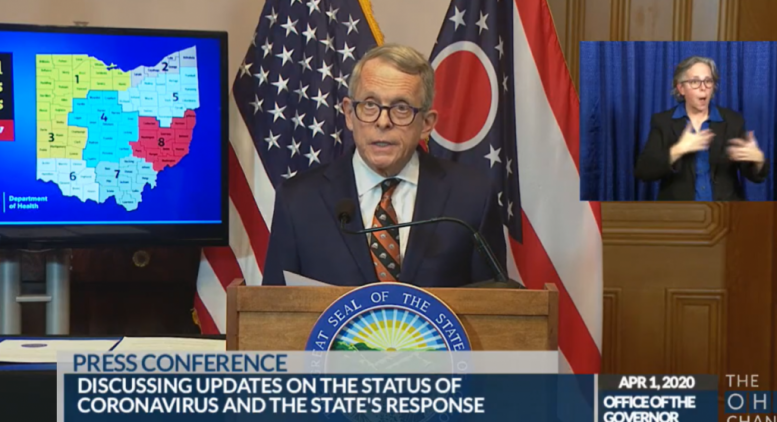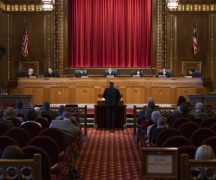Ohio Gov. Mike DeWine and the state’s legislative leaders on Friday announced how they’d allocate almost half of what the state has left in federal coronavirus-relief dollars.
The state has about $1 billion unexpended from its share of the $2.2 trillion CARES Act that Congress passed in March. At least until the feds change the rules, the funds have to be spent by Dec. 31.
Social-service groups that deal with issues of homelessness and hunger have been clamoring for months for a share of the money, as have business groups and others. So it’s been up to DeWine and the legislature to decide what to do with the money while Congress appears stymied over further coronavirus relief.
“We tried to look at what the needs were and what had already been put out,” DeWine said during a remote press conference. “We don’t know whether Congress will pass another bill or not.”
The state is holding about half of the funds for coronavirus testing and contact tracing and other needs while it awaits a possible second round of relief — which may or may not include assistance to state and local governments.
The expenditures announced Friday include:
- $50 million for mortgage and rental assistance to families making 200% or less of the federal poverty level
- $125 million for businesses with up to 25 employees
- $37.5 million for restaurants and bars
- $100 million for colleges and universities to do testing, contact tracing and provide mental-health services
- $62 million for rural and critical-access hospitals
- $25 million for non-profits providing services such a food banks, homeless shelters and other social services
- $20 million for the arts
A good deal more of the money was focused on businesses than on assisting individuals who are suffering most. But several in Friday’s press conference said they hope by helping small businesses keep their doors open, people will be able to get or keep jobs.
“We know some businesses are barely making it,” Lt. Gov. Jon Husted said of that portion of the package. “This is focused on them.”
For their part, some leaders of social-service organizations said they were grateful for the help they will receive.
“We’re pleased that Gov. DeWine finally deployed federal coronavirus relief funds to help people avoid getting evicted during this pandemic,” Bill Faith, executive director of the Coalition on Housing and Homelessness in Ohio, said in a written statement. “And we appreciate (Ohio) Controlling Board members’ support, especially Sen. (Matt) Dolan (R-Chagrin Falls) and Sen. (Jay) Hottinger (R-Newark) who took a personal interest in keeping struggling Ohioans safely in their homes. We look forward to seeing details on how the program will be implemented. Given the Dec. 31 deadline to use these funds, we would welcome the governor’s assistance in advocating for Congress to provide additional rental assistance into 2021.”
The Ohio Poverty Law Center also released a statement praising state leaders for their action. But it warned that it won’t be enough.
“As Ohioans continue to experience job and income loss due to the pandemic, additional federal and state resources will be needed to prevent evictions and keep Ohioans safe, especially as we get closer to the expiration of the Centers for Disease Control and Prevention’s eviction moratorium,” it said. “We hope housing assistance will be among the highest priorities for resources in the coming weeks and months.”
***
Also from Ohio Capital Journal:
Commentary: Across the political spectrum, Ohioans agree it’s time to repeal HB 6
When the controversial nuclear bailout bill known as HB 6 first reached the Ohio House floor in 2019, only a handful of Ohioans truly knew what it was and what was in it. This “handful of Ohioans” — as we would later find out — was a group of Republican lawmakers and lobbyists who had cooked up a historic alleged pay-to-play bribery scheme, all funded by various energy companies and predominantly led by FirstEnergy.
The plan was relatively simple: The companies intended to spend $60 million on lobbyists and Statehouse races to ultimately secure a $1.5 billion bailout from the Ohio state legislature. Of course, that $1.5 billion was to be paid for by consumers through increasing energy rates on Ohio households, while also cutting energy-saving programs that would have saved them $4 billion. While the bill was falsely sold as an “Ohio Clean Air Program,” its coal and nuclear plant bailouts made Ohio the first state to move backwards from its renewable energy goals. So overall, HB 6 was a terrible bill to begin with and comes off even worse now. HB 6 barely passed the Ohio legislature to make its way to Gov. Mike DeWine’s desk and all subsequent attempts to repeal or negate it via the ballot were beaten back with questionable and xenophobic tactics.
(See Wood County legislators and candidates views here and here and here.)
While it certainly caught the attention of Columbus’ savvy statehouse reporters — plus the influx of dark money spent on pro-HB 6 ads earned the national spotlight— Ohio voters wouldn’t know the full extent of the corruption behind HB 6 until the Federal Bureau of Investigation announced they were tracking the energy companies’ money and trailing the perpetrators the entire time. The five primary suspects were charged at the end of July, including now-former speaker of the House Larry Householder, former Ohio Republican Party chairman Matt Borges and three other political operatives. It seemed like justice had been served and the bad guys were busted. READ MORE
80% of Ohio House ‘elected by the deep state,’ GOP lawmaker Nino Vitale says
Four in five members of the Ohio House of Representatives were elected by “the deep state,” according to GOP state Rep. Nino Vitale.
The lawmaker made the remark in a Facebook comment in response to his own post, which misleadingly and incorrectly suggests the Ohio Department of Health will force state residents to take a COVID-19 vaccine if and when it becomes available.
“80% of the people in the statehouse were elected by the deep state,” he said. “The deep state put thousands of dollars into these candidates, they spike their name ID, lie about what they stand for, then the voters vote for them, thinking they are making a choice. That is who I serve with.”
Vitale regularly uses his Facebook account to air COVID-19 conspiracy theories and distortions, regularly driving thousands of interactions. Interactions broaden a post’s reach. READ MORE





